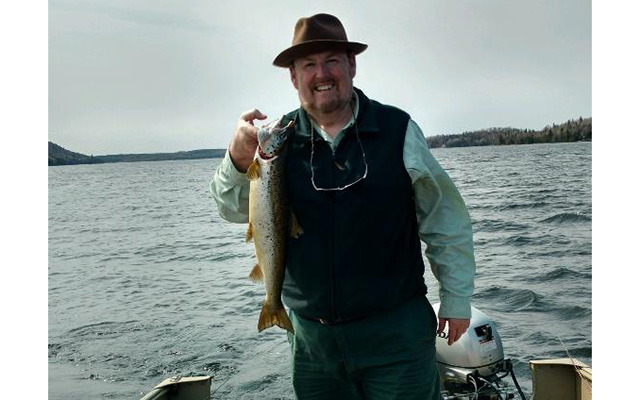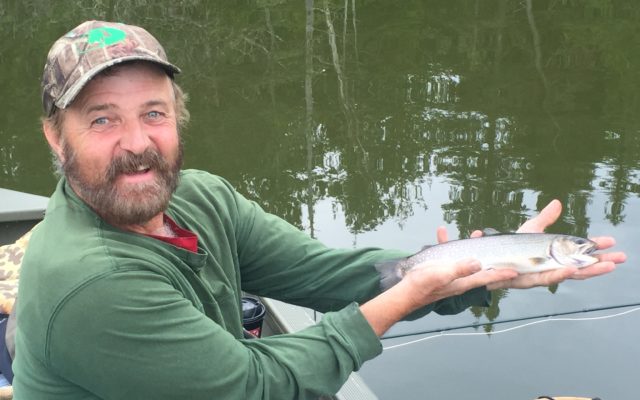Other than a couple of sunny days in the 70s, the last few weeks have been unusually cool, especially at night. For most anglers, this a good thing, as local lakes and ponds aren’t warming too fast and fish are still feeding near the surface and grabbing streamer flies and small lures. There’s still time for some productive trolling, so get out there before the warm weather changes water temperature and level.
Rapala, size 7 floating plugs are currently working well in blue/silver, black/silver, bright orange and perch colors. When trolled at moderate speed, these wobble like a swimming minnow and dive down to a depth of two to three feet. Silver Super Dupers, gold Al’s goldfish, red and white Dardevles and pounded copper Mooselook wobblers are also dependable. Another favorite of mine are Sutton Spoons, sizes 8, 88, and 44 in silver or silver/bronze for small ponds and most lakes, with larger sizes available for large lakes or deeper trolling. Real Sutton spoons have been difficult to find for a couple of years, but Ben’s Trading Post in Presque Isle currently has a good selection. Spoons are actually large lures and some of the original versions were really created from the bowl of kitchen spoons used for eating. The handles were cut off and the bowl was bent and shaped so they have a unique shake and shiver when trolled that really draws strikes.
My personal favorite style of trolling is to use a medium action 5- or 6-weight fly rod with a streamer fly. Tandem streamers on large lakes imitate smelts and size 4 or 6, 4X long shank singles duplicate a minnow when fishing ponds or rivers. Floating fly lines with at least a 10-foot leader or a sinking tip line with a 7-foot leader keep the streamers running at a perfect depth when trolling three to four mph.
- Bill Graves displays a hefty salmon taken on a red and white bucktail while trolling Van Buren Cove on Long Lake. (Contributed photo/Bill Graves)
Another technique proven to improve action involves steering the boat in a serpentine motion rather than straight ahead. Slow lazy S-curves cause a trolled fly to rise and drop as a real swimming bait fish might and hungry gamefish attack readily. If I’m holding the rod rather than have it in a stationary rod holder, I bob the tip every five to 10 seconds to add a bit more action as well. It does make a difference.
Long Lake is still offering consistent action and try Van Buren Cove, in front of Long Lake Sporting Club and along both sides of Pelletier Island. This waterway is the place to be for great salmon action, as three to five pound silver leapers are fairly common and every once in awhile will come along a trophy over 6 pounds. A visit to the sister Fish River gem, Cross Lake, means great trout trolling. The thoroughfare between Cross and Eagle has been hot and don’t overlook Salmon Point and Goddard Cove.
Another excellent brook trout option is the Aroostook River, but visit soon before water levels recede. Don’t forget to take along a dry fly rod, watch for intermittent insect hatches along the shoreline as you’re trolling, then stop, anchor up and cast floating flies while the surface hatch is ongoing. For a bit of variety, take a trip to Drew’s Lake near Houlton and trail a few lines in search of the unique and fairly rare brown trout. There are brook trout, salmon, pickerel and perch to keep lines tight as well.
Don’t overlook smaller lakes and ponds that may be close to your hometown. Fishing pressure is often lighter and pre- or post-work day trips easier to achieve. Echo Lake in Aroostook State Park is well stocked yearly with brook trout, easy to reach and simple to fish for folks from Presque Isle and nearby towns. There’s Monson Pond in Fort Fairfield, Durepo and Trafton lakes in Limestone, Hanson Lake in Mapleton and Blake Lake and Soldier Pond in Fort Kent area are available for Crown of Maine trolling enthusiasts.
Toward central Aroostook, anglers should investigate Portland Lake in Bridgewater, Carry Lake in Littleton or Cochraine, Timoney or Spaulding lakes near Ludlow and Oakfield. Most of these small waterways have boat launches and are simple to access but if you only have a 17- to 20-foot stable canoe, that will work too. It’s possible to troll by simply paddling a canoe, while an electric motor is another quiet, light alternative.
The wind has been an incessant factor most of this spring. Steady breezes at 14 mph with higher gusts ruin trolling mobility and safety. So pick a morning or evening with light wind and visit a local lake or river with your favorite trolling rig. The water’s right and the fish cooperative.
- Mike Wallace of Freeport prepares to release a nice trout taken while trolling streamer flies on a pond near Presque Isle. (Bill Graves)
- Tom Tardiff, a registered Maine Guide from Robinson, shows off a feisty trout that grabbed a colorful streamer fly trolled on a regional pond earlier this month. (Bill Graves)










